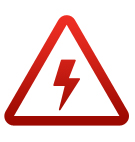

Browse through many products designed and manufactured to protect your work from the costly effects of Electrostatic Discharge (ESD).


WHAT IS ELECTROSTATIC DISCHARGE (ESD)?
Electrostatic discharge (ESD) refers to the abrupt surge of electric current between two electrically charged objects. This phenomenon can be triggered by various factors such as direct contact, electrical short circuits, or dielectric breakdown. The accumulation of static electricity may occur through processes like tribocharging or electrostatic induction.
The ramifications of ESD are particularly significant in the context of components and products housing electronic elements. This imperceptible adversary often lurks within cutting-edge manufacturing facilities. The resulting impairments frequently elude detection during quality control inspections, leading to immense frustration.
These setbacks have far-reaching consequences, encompassing diminished productivity, compromised quality, decreased product reliability, and, consequently, a substantial dent in a company's standing and profitability.


HOW DO I BECOME ESD PROTECTED?
You can protect your work using the below guidelines:
- Only handle unpackaged ESD sensitive items [ESDS] in the ESD protected area [EPA] when grounded
- Only allow trained or escorted people in the EPA
- Ground all conductors including people in the EPA
- Use continuous monitors or test wrist straps at least daily
- If ESD footwear is used, test at least daily
- Visually check that grounding cords are connected
- Keep wristband snug, foot grounder grounding tab in shoe, and ESD smocks covering all clothing on torso
- Keep work area clean and clear of all non essential insulators, or neutralise essential insulators with ionisers with the airflow directed towards the work area
- Use packaging with shielding properties to store or transport ESDS outside the EPA


WHAT IS A ESD PROTECTED AREA (EPA)?
An Electrostatic Discharge Protected Area (EPA) refers to a designated space equipped with essential ESD control measures aimed at minimising the risk of harming sensitive ESD-prone devices. In a broader context, this safeguarded zone possesses the capability to manage static electricity across all items that enter the workspace. This entails ensuring that personnel and other conductive or dissipative materials are interconnected and securely linked to a grounding point (or a communal connection hub in cases where a dedicated ground is unavailable). This practice ensures uniform electrical potential among these items.
The dimensions of an EPA can span a wide spectrum. It might encompass a fixed, permanent workstation within a room, or it could extend to an entire factory floor, accommodating numerous workstations. Moreover, an EPA can take the form of a portable work surface or mat, especially useful in field service scenarios.
An EPA could manifest as a solitary ESD workstation—an area carefully structured to exert effective ESD control. Within such a workstation, our endeavor revolves around curbing electrostatic charges. This is achieved through comprehensive grounding of all conductors, including individuals, the elimination of insulative materials (or their substitution with ESD-compliant alternatives), and the neutralisation of process-critical insulators using ionisers.
In addition to conductive and dissipative worksurfaces, personnel grounding devices and ionisers, your company may provide a variety of additional ESD control materials. The proper use of these materials will enhance your company’s ESD control program:
- ESD smocks and gloves
- ESD packaging, bags and boxes
- Conductive foam and shunt bars
- Antistatic or low charging tape
- ESD cleaners and topical antistat
- Dissipative bottles and cups
- Dissipative binders
- Dissipative document and badge holders
- Dissipative floor finishes
- Conductive paint and epoxy
- Conductive and dissipative flooring
- ESD hand lotion


WHAT DO I NEED TO SET UP AN ESD PROTECTED AREA?
Establishing a consistent electrical potential across surfaces, objects, individuals, and Electrostatic Sensitive Devices (ESDs) within a defined space is effortlessly accomplished by employing exclusively "groundable" materials. These materials boast an electrical resistance typically under 10^9 ohms. They are utilised for surface coverings, containers, and tool fabrication.
In this system, all surfaces, products, and individuals are effectively connected to the grounding point. This process, known as bonding, involves creating links usually characterised by resistances ranging between 1 and 10 megohms.
Moving entities, including containers and tools, achieve bonding by virtue of their placement on a bonded surface or being held by a bonded person. The EPA rigorously excludes any elements that do not readily dissipate charge.
Within the ESD protected area, conspicuous signage, often accompanied by aisle tape, serves to delineate its boundaries. It's imperative to grasp and adhere to the foundational principles of ESD control. This knowledge enables you to curtail the generation of ElectroStatic charges and regulate the discharge rate within the safeguarded ESD environment.
